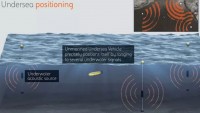DARPA Program Allows Swarms of U.S. Aerial Drones to Collaborate in Attacks
| Arthur Dominic Villasanta | | Jun 07, 2016 10:39 PM EDT |
USAF MQ-9 Reaper armed with smart bombs and Hellfire missiles.
A new project by the U.S. Defense Advanced Research Projects Agency (DARPA) is preparing the U.S. military to win a coming conventional war by allowing swarms of missile armed aerial drones to collaborate in launching long-distance strikes against enemy warships and mobile ground targets such as tanks despite intense enemy electromagnetic jamming.
Like Us on Facebook
DARPA's "Collaborative Operations in Denied Environment" (CODE) program intends to achieve these aims while reducing required communication bandwidth and decision-making burden on military personnel controlling these unmanned aircraft systems (UASs), also called unmanned aerial vehicles (UAVs).
CODE's main objective, however, is to develop and demonstrate the value of "collaborative autonomy" or swarm attacks by packs of hunter-killer drones. CODE will also allow UASs to perform sophisticated tasks both individually and in teams under the supervision of a single human mission commander.
The program will deliver a software system that is resilient to bandwidth limitations and communications disruptions but compatible with existing standards. It will also be capable of affordable retrofit into existing platforms such as the combat proven hunter-killer MQ-9 Reaper designed for long-distance and high altitude attacks.
Reaper can mount up to four Hellfire air-to-ground missiles and two 500 lb. GBU-12 Paveway II laser-guided bombs. It can also carry the 500 lb. Joint Direct Attack Munitions (JDAM).
If successfully demonstrated, these scalable, cost-effective capabilities should greatly enhance the survivability, flexibility and effectiveness of combat drones and reduce the development times and costs of future systems.
CODE-equipped combat drones will accomplish their missions by sharing data, negotiating assignments and synchronizing actions and communications among team members and with the commander. CODE's modular open software architecture on board the drones enables multiple CODE-equipped drones to navigate to their destinations and find, track, identify and destroy targets.
The CODE drones can also recruit similarly equipped drones from nearby friendly forces to augment their own capabilities and adapt to dynamic situations such as continuously attacking enemy targets. Phase 1 saw the development of supporting technologies for CODE.
"During Phase 1, we successfully demonstrated, in simulation, the potential value of collaborative autonomy among UASs at the tactical edge, and worked with our performers to draft transition plans for possible future operational systems," said Jean-Charles Ledé, DARPA program manager.
"Between the two teams, we have selected about 20 autonomous behaviors that would greatly increase the mission capabilities of our legacy UASs and enable them to perform complex missions in denied or contested environments in which communications, navigation, and other critical elements of the targeting chain are compromised. We have also made excellent progress in the human-system interface and open-architecture framework."
TagsDefense Advanced Research Projects Agency, DARPA, Collaborative Operations in Denied Environment, CODE program
©2015 Chinatopix All rights reserved. Do not reproduce without permission
EDITOR'S PICKS
-

Did the Trump administration just announce plans for a trade war with ‘hostile’ China and Russia?
-

US Senate passes Taiwan travel bill slammed by China
-

As Yan Sihong’s family grieves, here are other Chinese students who went missing abroad. Some have never been found
-

Beijing blasts Western critics who ‘smear China’ with the term sharp power
-

China Envoy Seeks to Defuse Tensions With U.S. as a Trade War Brews
-

Singapore's Deputy PM Provides Bitcoin Vote of Confidence Amid China's Blanket Bans
-

China warns investors over risks in overseas virtual currency trading
-

Chinese government most trustworthy: survey
-

Kashima Antlers On Course For Back-To-Back Titles
MOST POPULAR
LATEST NEWS
Zhou Yongkang: China's Former Security Chief Sentenced to Life in Prison

China's former Chief of the Ministry of Public Security, Zhou Yongkang, has been given a life sentence after he was found guilty of abusing his office, bribery and deliberately ... Full Article
TRENDING STORY

China Pork Prices Expected to Stabilize As The Supplies Recover

Elephone P9000 Smartphone is now on Sale on Amazon India

There's a Big Chance Cliffhangers Won't Still Be Resolved When Grey's Anatomy Season 13 Returns

Supreme Court Ruled on Samsung vs Apple Dispute for Patent Infringement

Microsoft Surface Pro 5 Rumors and Release Date: What is the Latest?













